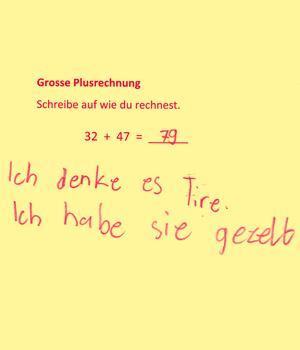100 Ways of Doing Addition
Kids Calculate Differently Than (Many) Adults Think – Some Kids Calculate Differently Than Other Kids
For kids and adventurous adults:
Take one of the slips of paper with an addition problem on it, then solve it. Show how you solved the problem.
Take the slip of paper with you when you go through the exhibition. Is there a kid somewhere who solved the problem the same way you did?
Have you ever thought about how you solve addition problems? Many adults think there's only one way to solve them, and that there's a particularly easy way. Many adults learned as much when they were in school. But studies show that there is no one easiest way to solve arithmetic problems. Rather, there are many different possibilities. An easy way to do it for one person can be difficult for someone else.
These days, arithmetic books advise teachers to try various methods for solving problems. This helps kids better understand the numbers from zero to one thousand. It sometimes happens that solving a problem in different ways results in different or incorrect solutions. In these cases, it's important that kids are instructed by their teachers to try and solve the problems in another way.
The exhibited examples come from test booklets used in various research projects at the Institute for Special Education, Learning, and Integration. The purpose of these projects is always to help kids who have difficulty with arithmetic. In the tests that were developed, not only the solution but also the way in which the student solved the problem were evaluated.
Related contributions
